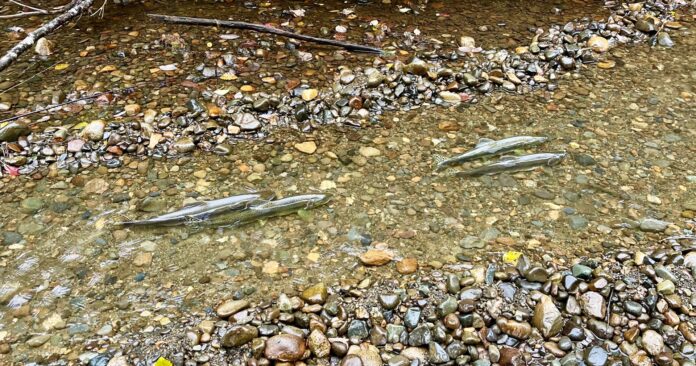Volunteers with the Tsolum River Restoration Society were surprised to find the waters of the Tsolum River full of Pink Salmon this fall, after a difficult drought season.
According to the non-profit, volunteers counted on Sept. 30 and found an estimated 300,000 pink returns, which they say is heartening as the river has faced many challenges over the years.
In August, the province declared the Tsolum at a Level 5 drought, and restricted water usage to the surrounding area. That was combined with the heat dome of 2021 and previously the river was damaged by toxic copper leachate from an abandoned mine site.
However, the mine site was covered in 2009/10 and following the heat dome there has been a reprieve for the fish, which is what project coordinator Katie Gair says may have made the difference this year.
“I think the river levels were slightly higher this year, we did get precipitation a little earlier than we did in 2021. That was a bit of a saving grace for our poor fish,” said Gair.
Gair adds the Tsolum also tends to be a very “flashy” river, meaning it will go from peak water level to low water level very quickly.
She adds the results are really good to see, however, while it looks good for pink, it is more difficult to tell for other species that are found in the river. The society says coho, chinook, chum salmon, cutthroat, rainbow and steelhead trout are struggling to recover as fast as the pinks have.
“Pink has such a short life span that they are able to recover more quickly, they only have a two-year life cycle,” said Gair. “Coho and chum have about a four or five [year], chinook have a seven [year cycle]. Those longer generation times don’t allow them to recover as quickly.”
While the society would like to say there will be more years like this ahead for pink and other salmon, it is possible this year could have been a one-off.
“There’s so many factors to contribute to salmon returns and escapement (salmon getting out of the river and going into the ocean),” said Gair. “I really hope we’re going to be seeing these numbers more consistently, but 2025, we may see half the amount.”
Heading forward, Gair says there needs to be a balance between water supply for agriculture and keeping water in the river.
“Having watershed-based conservation planning, looking at all the factors that effect a watershed, trying to engage all the industries that affect it, and trying to meet people at their current capacity and their current capability,” said Gair.
“Trying to have a more holistic approach to conservation and trying to be more interdisciplinary and get more people on board.”
The society adds there are other things you can do to protect the salmon population, including being mindful of eggs and juveniles while walking on the river, and not being mindful of releasing soaps, oils and contaminants into the water.
More information and ways to support the society can be found on the TRRS website, or by calling 250-897-4670.






